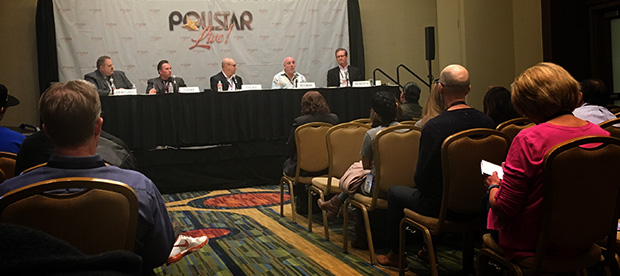
Between IAVM’s Academy for Venue Safety and Security (AVSS), GuestX, and SevereWeather Preparedness (currently underway), and the safety and security session at Pollstar, venue managers and security professionals have recently shared a tremendous amount of insight and resources with one another.
The Pollstar panel, moderated by Eric Colby (AVSS faculty), featuring Lee Zeidman (STAPLES Center, Microsoft Theater, L.A. Live); Jim Mercurio (Levi’s Stadium); Captain Phil Cooke (Super Bowl 50, Santa Clara Police Department); and Cory Meredith (Staff Pro), explored lessons learned and smart practices shaped by recent incidents affecting the safety and security landscape.
Fresh off of Super Bowl 50, Mercurio and Cooke described an operation of massive proportions, including 15,000-plus credentialed staff and crew, 200 magnetometers, and more than 1,000 calls for service (janitorial, medical, etc.) during the game. To supplement the onsite operations, a situation room monitored everything from area traffic to social media content and global events (social media tracking led to preventing a few attempts by guests to access the field).
The relationship between visible and invisible security was a significant point of discussion during the session, and monitoring social media content associated with an event is one example that was shared of the emerging ways that venue teams are supplementing traditional frontline security. Having visible police with a sidearm remains an important deterrent, but as the panel discussed, an invisible layer of security and support behind them is an important aspect of modern security.
Three Ways to Improve Your Venue Safety and Security
During the session, Zeidman shared three very accessible ways that every venue manager can improve their safety and security.
1. Foster Great Relationships With Law Enforcement
“We host training sessions in our venues, have weekly meetings to cover upcoming events, and share extra tickets to games and events with the police and fire departments whenever we can,” Zeidman said.
2. Table Top Exercises
At Zeidman’s venues, issues such as earthquakes, bomb threats, and active attacker scenarios are worked into staff exercises that engage all staff positions—with Zeidman emphasizing all staff.
Similarly, at AVSS and GuestX this week, all attendees participated in IAVM’s American Airlines Center Experience. Developed by Paul Turner, CFE, CSSP (AT&T Stadium) and Ed Klima (Dover International Speedway), the event included a table top exercise for more than 200 attendees—immersing several small groups into focused discussions on managing various aspects of a large rigging accident occurring during a concert.
“The exercise enabled the entire group to collaborate on multiple aspects of a very plausible scenario,” Turner said, “And it equipped everyone with a great example of how to coordinate training exercises with their own teams back home.”
3. Improving Visibility
Following the Paris attacks, Zeidman shared that he expanded the use of K9 Units to include public areas around the venue instead of primarily focusing on vehicle searches in private areas. Improving visibility, and doing so consistently, is very important to Zeidman, regardless of the type of event or the makeup of the crowd attending.
“People want to see a show of force because they want to feel comfortable and safe,” Zeidman said. “And it shouldn’t change because the event changes. I’m not going to be the one who allowed something to happen at a certain event because we downplayed a security plan.”
As both the session at Pollstar, and the sellout crowd at AVSS show, venue safety and security is demanding more attention and training than ever, and will undoubtedly continue to draw us together for new thinking and ongoing collaboration to ensure a vibrant, safe, and secure future.

Hola, soy Jorge Páez, licenciado en protección civil y emergencias y responsable del área operativa del Comité de Prevención y Seguridad para Eventos Deportivos del Gobierno de la Ciudad de Buenos Aires , Argentina. He leído la publicación y si bien es cierto que la mismas muestra algunos aspectos de como se tratan algunos puntos de la seguridad, no me dejan ver la complejidad de como se hace y como se preparan. Nosotros estamos bastante lejos de tomar la seguridad como lo hacen Uds.
Es por eso que me interesa poder aprender de Uds. para encarar todos los aspectos de seguridad con una perspectiva más profesional y enfocar la problemática con una planificación estratégica integral del Riesgo y de la seguridad.
Por lo dicho mucho agradeceré me incluyan en programas de capacitación sobre la seguridad en eventos masivos y deportivos.
Desde ya Muchas Gracias
Cordialmente los Saluda
Lic. JorgeH. Páez